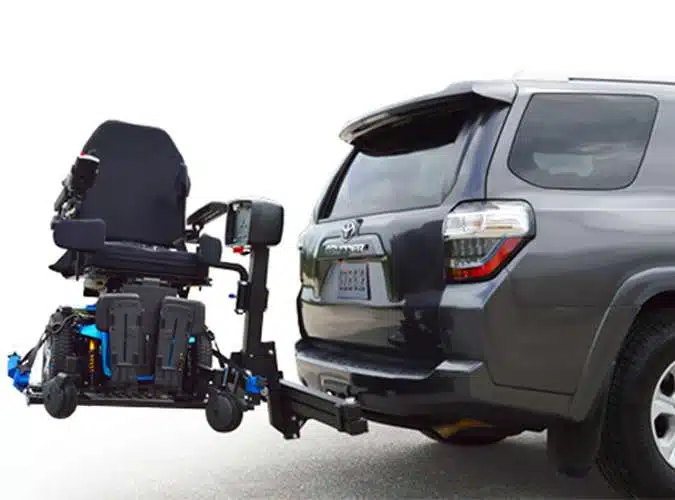We get it. It’s not easy figuring out how to transport a mobility scooter.
You’re not alone. Transporting mobility scooters can be tricky, but there are many options designed with the user in mind that will help safely get your scooter from point A to point B.
Whether you need a hitch-mount lift or want some help loading your mobility device into your vehicle, there are solutions you can use!
This article will explore the different methods of mobility scooter transportation and the pros and cons of each method.
We’ll also answer some questions about handling a mobility scooter so that you can decide with more information in hand.
Transporting a wheelchair or mobility scooter can be a challenge.
Some mobility devices are easy to transport. These can include certain manual wheelchairs and collapsible lightweight mobility scooters. These can be folded down and lifted into the vehicle for transport. It is relatively easy to transport lightweight mobility scooters and wheelchairs in vehicles – yes, even small cars.
Powered wheelchairs and heavy rigid mobility scooters are more difficult to transport because they do not collapse and tend to be too heavy for one person to lift. As a result, transporting these mobility devices requires a little more thought.
How To Transport a Mobility Scooter
For people using mobility devices, their most frequent travel is by private vehicle. Most often, this is due to more difficulty and inconvenience in using other forms of public transport.
How to Handle a Mobility Scooter
Often, it’s easier to fold lightweight, collapsible mobility scooters, and manual wheelchairs, then lift them into any vehicle’s cargo space.
This is not possible for heavier, rigid mobility scooters and powered wheelchairs. These devices need the use of the appropriate mobility scooter ramp or lift to transport them safely.
Where to Put a Mobility Scooter or Wheelchair
Collapsible scooters and wheelchairs can sometimes fit behind the front seats of a car or SUV or utility vehicles that have space behind the seats in the cab. But most people find it easier to put these in the cargo space. Powered wheelchairs and rigid mobility scooters must be transported in the cargo area or on a vehicle lift mounted to a hitch on the car.
Ramps work if someone can move the ramp and there is enough space around the vehicle to use it. But in tight spaces or where you don’t have an extra pair of hands, vehicle ramps can pose a problem.
Scooter and Wheelchair Lifts
You can choose between inside auto lifts or hoists, outside lifts, or hybrid auto lifts. Each has its own set of benefits.
Inside Hoists
These are a great solution for people in a wheelchair or scooter. The inside lift has an easy-to-use hoist mechanism that swings outside to load mobility devices with ease. Once raised, it’s important to help guide the mechanism and mobility device into the cargo area.
Hitch-mount/Outside Lifts
An outside auto lift attaches to the back of your vehicle with a hitch. Your scooter or wheelchair is secured to the platform, raised, and transported outside the vehicle.
These lifts are easy to use and work well for most vehicles. When not in use, their hinged design allows these lifts to take up very little space behind the car by folding the platform.
Hybrid Lifts
These lifts are fixed in the cargo area of the vehicle. To use them, the platform extends out through the open trunk door and then lowered to the ground. You can then guide your mobility device onto the platform.
The platform is then raised and retracts back into the vehicle, stowing your mobility scooter or powerchair inside.
Travel by Bus or Train
Wheelchairs and collapsible mobility scooters can access buses. Secure your scooter or wheelchair to the bus floor or seat with restraints for safety reasons.
The driver will stop as close to your destination as possible so that you can get off of the bus easily. Let them know where you are heading before boarding the vehicle.
Long-distance buses can also store manual wheelchairs and foldable mobility scooters. But they may not have enough cargo space to stow powered wheelchairs and heavy rigid mobility scooters.
There is more space on trains to access with any mobility scooter or wheelchair. In addition, there are ramps available at stations or on the train to allow safe access. Let the conductor know which station you are getting off.
It can be difficult and sometimes not possible accessing both buses and trains at peak times.
Travel by Airplane
Commercial airlines will accept battery-powered mobility scooters and wheelchairs as cargo for people with limited mobility or disabilities. But regulations determine the power and type of battery, for example, lithium batteries or sealed lead acid or gel batteries.
Before booking your flights, confirm your carrier’s rules about powered mobility devices. And ensure your mobility scooter or wheelchair meets the airline’s requirements.
Is Your Mobility Device Insured in Transit?
Most people have their mobility scooters or powered wheelchairs insured for everyday use. However, it is important to check with your insurer that your mobility device is insured in transit.
Transportation insurance may vary from insurer to insurer, and you will find that most public transport carriers have limitations on cover per item.
Don’t get caught out. Mobility devices are expensive. Make sure you are covered in all circumstances.
Other Tips for Transporting Mobility Devices
Here are a few musts when transporting your scooter or wheelchair.
- Make sure your mobile device is secured in the vehicle or on the platform
- Turn off the power in transit. It is no fun arriving at your destination with a flat battery. And make sure you pack your battery charger
- If you have a hitch-mounted outside lift, use a weatherproof cover to protect your scooter or wheelchair from the elements
Shop our extensive line of vehicle lifts today and make getting around a little easier.




